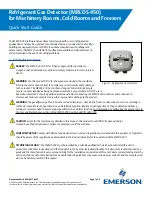
V-2
UV DETECTOR POSITIONING
Detectors should be positioned to provide the best
unobstructed view of the area to be protected. The
following factors should be taken into consideration:
• Identify all high risk fire ignition sources.
• Be sure that enough detectors are used to adequately
cover the hazardous area.
• For fastest response time, locate the detector as close
as possible to the anticipated fire source. The central
axis of the detector’s cone of vision provides the
highest sensitivity.
• Be sure that the unit is easily accessible for cleaning
and other periodic servicing.
• Particular attention should be paid to potential false
alarm sources within the cone of vision of the detector.
• For outdoor applications, the detector should be
aimed downward at least 10 to 20 degrees to prevent
it from scanning the horizon. This minimizes response
to distant UV sources outside the protected area. See
Figure 1.
• Dense fog, rain or ice will absorb UV radiation and
reduce the sensitivity of the detector.
• If smoke is expected before flame, it is recommended
that smoke or other additional detectors be used in
conjunction with the UV detector.
If possible, fire tests should be conducted to verify
correct detector positioning and coverage.
UV/IR DETECTORS
FALSE ALARM SOURCES
UV:
The UV sensor is insensitive to the ultraviolet
component of solar radiation. However, it will
respond to sources of UV besides fire, such as
electric arc welding, lightning, high voltage corona,
x-rays and gamma radiation.
IR:
The detector has been designed to ignore steady
state infrared sources that do not have a flicker
frequency characteristic of a fire, however, it should
be noted that if these steady state infrared sources
are hot enough to emit adequate amounts of
infrared radiation in the response range of the IR
sensor and if this radiation becomes interrupted
from the view of the detector in a pattern
characteristic of a flickering flame, the IR sensor
can respond.
Any object having a temperature greater than 0°
Kelvin (–273°C) emits infrared radiation. The hotter
the object, the greater the intensity of the emitted
radiation. The closer the infrared source is to the
detector, the greater the potential for a false alarm.
The IR sensor can respond to IR radiation sources
that can meet the amplitude and flicker
requirements of the detector such as vibrating hot
objects.
Although the detector is designed to reduce false
actuations, certain combinations of ambient
radiation must be avoided. For example, if IR
radiation with an intensity that exceeds the fire
threshold of the IR sensor should reach the detector
as a flickering signal, and if at the same time an
electric arc welding signal also reaches the
detector, an alarm output will be generated.
NOTE
Radiation generated by false alarm sources such
as periodic lightning or sparks in the area can be
effectively ignored by the detector using the arc
rejection feature or time delay.
Arc Welding
Electric arc welding is a source of intense ultraviolet
radiation. UV radiation from arc welding readily scatters
and can deflect across significant distances, even when
direct obstructions exist. Any open door or window can
allow nuisance UV radiation from arc welding to enter
an enclosed area.
CENTER AXIS
OF DETECTOR
FIELD OF VIEW
CENTER AXIS
OF DETECTOR
FIELD OF VIEW
INCORRECT
CORRECT
NOTE: DETECTOR MUST ALWAYS BE AIMED
DOWNWARD AT LEAST 10 TO 20 DEGREES.
B1974
Figure 1—Detector Orientation Relative to Horizon
















































